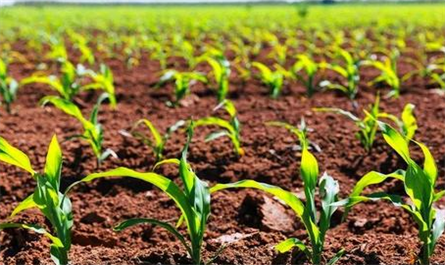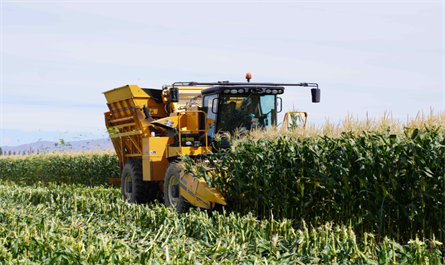Field management skills for corn in the middle and late stages
When corn enters the jointing stage, it is the most vigorous growth period in its life, with both vegetative growth and reproductive growth going hand in hand. It is also a critical period for field management to achieve high yields, and it must be highly valued. Here are some field management skills for corn in the middle and late stages, hoping to help you grow high-yield corn.

1. Intertillage and weeding: timely intertillage, loosening and weeding, and soil cultivation should be carried out to promote soil loosening, increase soil permeability, and promote root growth.
2. Scientific water management: In rainy seasons, corn fields should pay attention to timely drainage.
3. Reasonable fertilization: High-yield corn, large ears, many grains, and heavy grains require heavy ear fertilizer. The large trumpet mouth stage (about 12 days before tasseling) is the critical period for corn to require water and fertilizer. At this time, fertilization is the best. Fertilization too early or too late will not be effective. Apply 25-30 kg of urea per mu, apply deep beside the roots, and cultivate the soil after application to prevent fertilizer volatilization and loss and lodging. The key to corn being full of fruit and not bald is to apply granular fertilizer skillfully. Apply 15 kg of urea per mu during the tasseling and silking period, and cover the soil after application to prevent the volatilization and loss of fertilizer.
4. Artificial emasculation: Artificial emasculation can generally increase production by about 10% as long as the method is appropriate. It should be carried out when the male spike has just emerged but has not bloomed and scattered pollen. When emasculating, remove every other row, or emasculate every other plant, generally not more than 1/2 of the total number of plants in the field. Do not emasculate near the edge of the field or the head of the field to avoid affecting pollination. After pollination, all the male spikes can be cut off to increase the light of the group. Be careful not to remove the leaves when emasculating.
5. Auxiliary pollination: Artificial assisted pollination can promote good pollination of the female spike and increase the fruiting rate. It is an important measure to prevent baldness. When the pollen is spreading in the morning, pick 2-3 male spike branches and shake the pollen onto the female spike. This can usually be done 2-3 times in a row. You can also use a long bamboo to gently move the spike at 9-10 am.
6. Remove small plants: Before the corn tassels emerge and before and after silking, remove a few small and weak plants that have no ability to form sticks, which can save water and fertilizer and facilitate ventilation and light transmission in the field.
7. Strengthen comprehensive pest and disease control: The middle and late stages of corn growth are the peak period for corn pests and diseases.
8. Harvest at the right time: Generally, when the corn husks are dry and loose, the kernels become hard and shiny, the milk line disappears, and a black layer appears at the base, it is fully mature, and the harvest yield is the highest at this time.
In addition, by using plant growth regulators, the yield of corn can be increased and the quality of corn can be improved.

Gibberellic Acid(GA3): Used when the filaments begin to burn after the female flowers of corn are fertilized, it can reduce bald tips, increase the number of grains, promote filling, and increase the thousand-grain weight.
Sodium nitrophenolate(Atonik): Used after the corn is tasseled, it can make the corn grains plump, increase the weight, increase the yield, and promote early maturity
Diethyl aminoethyl hexanoate(DA-6): Soak the seeds in 6-10mg/L Diethyl aminoethyl hexanoate(DA-6) solution for 12-24h, remove them and dry them before sowing, which can be advanced Seedlings emerge, seedlings grow strong, and increase the dry weight of roots
Brassinolide: Spray 10mg/L of amikacin during the tasseling period of corn, observe the main characteristics of corn ears, and comprehensively analyze its application effect and application cost. It shows that spraying amikacin during the tasseling period of corn has a significant yield-increasing effect.
Ethephon: It can promote root development, shorten stalks and strengthen stalks, enhance field ventilation and light transmission, and promote early maturity.
The above are the mid- and late-stage field management skills of corn shared with everyone, I hope it can help everyone grow high-yield corn.
Pinsoa supply related plant growth regulator use for corn planting,welcome to consult more.
admin@agriplantgrowth.com

1. Intertillage and weeding: timely intertillage, loosening and weeding, and soil cultivation should be carried out to promote soil loosening, increase soil permeability, and promote root growth.
2. Scientific water management: In rainy seasons, corn fields should pay attention to timely drainage.
3. Reasonable fertilization: High-yield corn, large ears, many grains, and heavy grains require heavy ear fertilizer. The large trumpet mouth stage (about 12 days before tasseling) is the critical period for corn to require water and fertilizer. At this time, fertilization is the best. Fertilization too early or too late will not be effective. Apply 25-30 kg of urea per mu, apply deep beside the roots, and cultivate the soil after application to prevent fertilizer volatilization and loss and lodging. The key to corn being full of fruit and not bald is to apply granular fertilizer skillfully. Apply 15 kg of urea per mu during the tasseling and silking period, and cover the soil after application to prevent the volatilization and loss of fertilizer.
4. Artificial emasculation: Artificial emasculation can generally increase production by about 10% as long as the method is appropriate. It should be carried out when the male spike has just emerged but has not bloomed and scattered pollen. When emasculating, remove every other row, or emasculate every other plant, generally not more than 1/2 of the total number of plants in the field. Do not emasculate near the edge of the field or the head of the field to avoid affecting pollination. After pollination, all the male spikes can be cut off to increase the light of the group. Be careful not to remove the leaves when emasculating.
5. Auxiliary pollination: Artificial assisted pollination can promote good pollination of the female spike and increase the fruiting rate. It is an important measure to prevent baldness. When the pollen is spreading in the morning, pick 2-3 male spike branches and shake the pollen onto the female spike. This can usually be done 2-3 times in a row. You can also use a long bamboo to gently move the spike at 9-10 am.
6. Remove small plants: Before the corn tassels emerge and before and after silking, remove a few small and weak plants that have no ability to form sticks, which can save water and fertilizer and facilitate ventilation and light transmission in the field.
7. Strengthen comprehensive pest and disease control: The middle and late stages of corn growth are the peak period for corn pests and diseases.
8. Harvest at the right time: Generally, when the corn husks are dry and loose, the kernels become hard and shiny, the milk line disappears, and a black layer appears at the base, it is fully mature, and the harvest yield is the highest at this time.
In addition, by using plant growth regulators, the yield of corn can be increased and the quality of corn can be improved.

Gibberellic Acid(GA3): Used when the filaments begin to burn after the female flowers of corn are fertilized, it can reduce bald tips, increase the number of grains, promote filling, and increase the thousand-grain weight.
Sodium nitrophenolate(Atonik): Used after the corn is tasseled, it can make the corn grains plump, increase the weight, increase the yield, and promote early maturity
Diethyl aminoethyl hexanoate(DA-6): Soak the seeds in 6-10mg/L Diethyl aminoethyl hexanoate(DA-6) solution for 12-24h, remove them and dry them before sowing, which can be advanced Seedlings emerge, seedlings grow strong, and increase the dry weight of roots
Brassinolide: Spray 10mg/L of amikacin during the tasseling period of corn, observe the main characteristics of corn ears, and comprehensively analyze its application effect and application cost. It shows that spraying amikacin during the tasseling period of corn has a significant yield-increasing effect.
Ethephon: It can promote root development, shorten stalks and strengthen stalks, enhance field ventilation and light transmission, and promote early maturity.
The above are the mid- and late-stage field management skills of corn shared with everyone, I hope it can help everyone grow high-yield corn.
Pinsoa supply related plant growth regulator use for corn planting,welcome to consult more.
admin@agriplantgrowth.com
RECENT POSTS
Featured News



